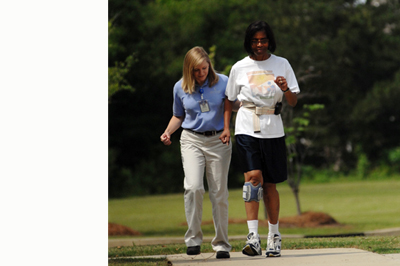As a TV camera whirs, Yvonne Porter executes some jumping jacks and jogs a few steps.
The Madison retiree is demonstrating how a new electronic device has helped her overcome the crippling effects of a condition called foot drop.
“I’ve told a lot of people I’m going to be the Bionic Woman,” said Porter, who volunteered to be the subject of a WLBT Medical Matters spot. “Now I can confidently go outside and walk without the fear of falling.”
The muscles that lift Porter’s foot were weakened by multiple sclerosis. Foot drop also can be caused by stroke, cerebral palsy, Parkinson’s disease, brain injury or incomplete spinal cord injury.
In the past, the only remedy was a rigid foot brace – hardly a favorite accessory for a woman who loves fashionable shoes. So when Porter got wind of a device that stimulates weakened or paralyzed muscles, she immediately wanted to know more.
Her neurologist referred her to Methodist Outpatient Neurological Rehabilitation in Flowood, where she was able to try out the Ness L300. A similar device called the WalkAide is available at Methodist Rehab’s Orthotics & Prosthetics clinics.
The devices aren’t for everyone with foot drop. Because they employ an electrical current, they aren’t appropriate for people with cardiac pacemakers or defibrillators. Nor are they recommended for people who have fractures, dislocations or cancer in the leg.
But for those who meet the criteria, the devices provide a variety of benefits, said Rhonda Fetcko, a physical therapist at Methodist Rehab. “I like that the device stimulates muscles that are weak or paralyzed while the person is walking,” she said. “It is like getting therapy when you’re just walking around.”
The devices work like this: Electrodes contained in a cuff worn just below the knee provide gentle stimulation to the peroneal nerve. Located on the outside of the lower leg, this nerve activates the muscles that lift the foot during walking. Specially trained staff at Methodist Rehab fine-tune the electrical stimulation to create the most effective walking pattern for each user.
Once the settings are determined, users can make some adjustments on their own, Fetcko said. “Yvonne can change the intensity if she is going up stairs and needs more ankle flexion. And she can increase it in the afternoon when she is fatigued, which often happens with people who have MS.”
The electrodes can evoke a light tingling sensation, which can be disconcerting for some. Jennifer Long, clinical manager for Methodist Orthotics & Prosthetics in Flowood, well remembers Steve Appelbee’s reaction when he tried the Walk-Aide for the first time.
“He got very emotional,” she said. “He said it had been seven years since he had a stroke and he hadn’t felt anything in his right leg since then. When he actually felt the nerve impulses – it was a big thing for him.”
“It was like wow – my leg is like it is supposed to be,” said the Madison resident. “It feels natural just walking.”
Porter said the device has restored her confidence. “Before, I didn’t have confidence because I had a fear of falling. Now I can go in the yard without my husband watching me or walk around the block without someone having to go with me. It’s freedom.”
Now that she’s more steady on her feet, Porter has plans to return to favorite activities like shopping and going to the gym. And she already has next year’s Multiple Sclerosis Walk on her calendar. “I said if I had my machine this year I probably wouldn’t have come in last.”
Appelbee also planned to take advantage of his new capabilities, and he was especially looking forward to a special day in June. “When we first started talking about this device, I remember he talked about our daughter Jill’s wedding and how he would be able to walk down the aisle without a brace,” said his wife Tricia.
“I just wanted to be more normal for her wedding,” he said.

